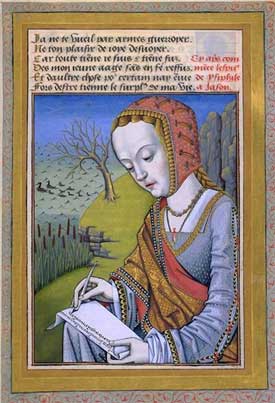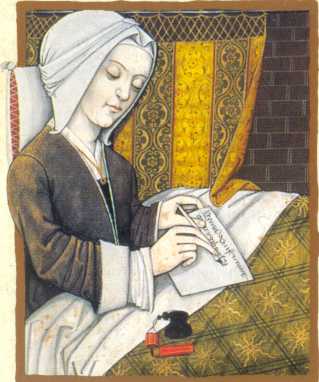by Tracy Barrett (W&M contributor)
That is, reading women (the act of reading works written by women) and reading women (women who read).
 When I received a grant from the NEH to study texts about women written by women in the Middle Ages, many of my friends were puzzled that this was possible. “Medieval women were literate?” Well, yes—and some of them produced among the most interesting texts of the period.
When I received a grant from the NEH to study texts about women written by women in the Middle Ages, many of my friends were puzzled that this was possible. “Medieval women were literate?” Well, yes—and some of them produced among the most interesting texts of the period.
Depending on the time, the definition of literacy (reading and writing, or just reading? Latin and the vernacular, or just one?), and the geographical region, estimates of female literacy in the Middle Ages vary between 1% and 50% (the ability to read and write in Latin produces the lowest figure). Members of the upper class of both sexes made up the vast majority of the literate, no matter what the definition, and there’s little reason to believe that more medieval men than women were literate in the vernacular.
Some scholars have credited women with spurring the growth of vernacular literature at the end of the Middle Ages, for several reasons. Perhaps the most important is that since women were largely unable to read Latin, love-poetry addressed to them had to be written in the vernacular, or the verse wouldn’t have its desired effect.
The growth of universities in the thirteenth century, usually heralded as a new burst of knowledge in Europe, actually led to the lowering of expectations for women. Now that the possibility of higher education was open to boys, families of the lesser nobility and merchant classes tended to neglect their daughters’ instruction in order to prepare their sons for this opportunity.
Women were not, however, always excluded from universities. Records refer to women teaching “law, philosophy, rhetoric and medicine at Bologna and other Italian universities in the thirteenth centuries. . . . But it is fairly certain that even in Italy, universities provided women with neither a formal education nor a license to teach.”1 One instructor named Novella reportedly had to lecture to her classes at the university of Bologna from behind a screen, so as not to distract her students with her beauty.

Northern Europe proved, in general, to be more hospitable to female literacy than the south. Barbarians thought letters unmanly, even (or especially) for rulers. The Gothic Queen Amalasuintha (c. 494-535) “wanted to mold [her son] Athalaric on the pattern of a Roman ruler, and engaged tutors to oversee his education. Her plan was thwarted by the Goths’ conviction that literary pursuit was unmanly. Enforced study drove a youth to cower before his teachers–old men at that. . . . The noble advisers . . . summoned evidence that Theodoric had looked unfavorably on the enfeebling effects of book learning.”2
The husband of St. Margaret of Scotland, King Malcolm, admired his wife’s ability to read. Charlemagne was probably illiterate while at least one of his wives was probably literate, and his daughter Bertha wrote a lengthy history, Historiarum libri quator. William the Conqueror’s wife, Matilda of Flanders, was better educated than her husband. Hugh of Fleury dedicated his Historia ecclesiastica to Adela, daughter of William the Conqueror, rather than to “illiterate princes who scorn the art of literature.”3
Perversely, women’s very exclusion from writing helped them to compose some of the most interesting medieval texts. In most cases there was no fixed definition of what women could write–no “canon.” With few exceptions, they did not confront a long publishing tradition and try to break into it. Much of their writing thus seems to the tastes of many modern readers fresher, more original, and often more interesting than that of their male contemporaries.
1Phyllis Stock. Better than Rubies: A History of Women’s Education. New York: G. P. Putnam’s Sons, Capricorn Books, 1978, p. 25.
2Karen Cherewatuk and Ulrike Wiethaus, eds. Dear Sister: Medieval Women and the Epistolary Genre. Philadelphia: University of Pennsylvania Press, 1993, p. 75.
3Alexandra Barratt, ed. Women’s Writing in Middle English. London and New York: Longman, 1992, pp. 76-77.
 Tracy Barrett is the author of numerous books for young readers, most recently Dark of the Moon (Harcourt) and the Sherlock Files series (Henry Holt). Forthcoming from Harlequin Teen in July, 2014 is The Stepsister’s Tale. She lives in Nashville, TN, where until last spring she taught Italian, Humanities, and Women’s Studies at Vanderbilt University. Visit her website and her blog.
Tracy Barrett is the author of numerous books for young readers, most recently Dark of the Moon (Harcourt) and the Sherlock Files series (Henry Holt). Forthcoming from Harlequin Teen in July, 2014 is The Stepsister’s Tale. She lives in Nashville, TN, where until last spring she taught Italian, Humanities, and Women’s Studies at Vanderbilt University. Visit her website and her blog.
